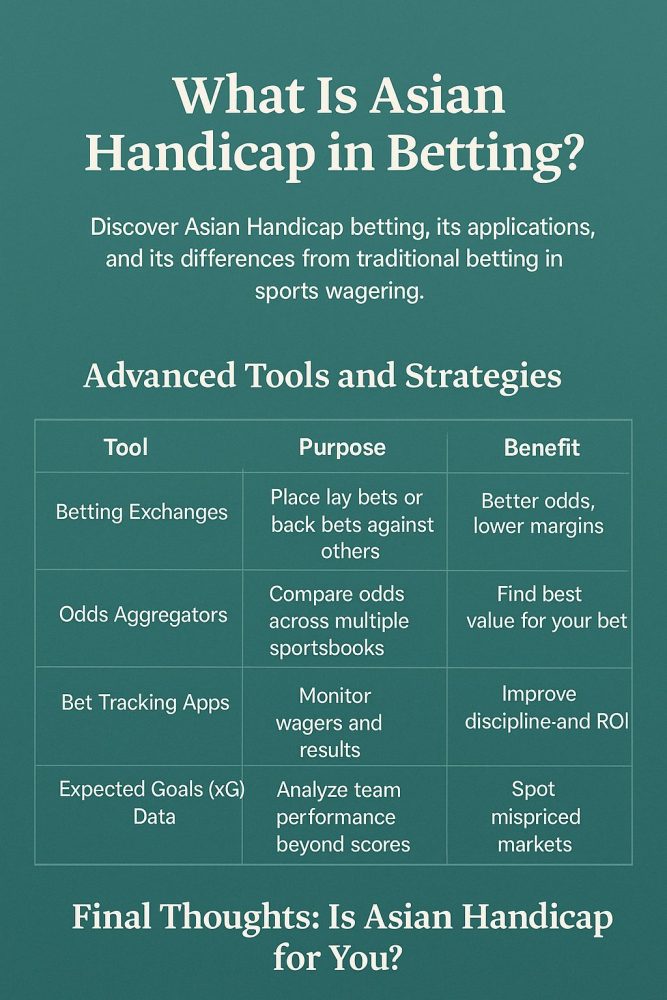Sports betting is a constantly evolving arena, and for those aiming to move beyond basic wagering techniques, asian handicap betting offers a sophisticated alternative. Particularly popular in soccer betting markets, this style of bet originated in Asia and is designed to eliminate the possibility of a draw. By doing so, it provides more balanced odds and potentially better value for experienced bettors looking to gain an edge.
In this comprehensive guide, we’ll break down the concept of Asian Handicap betting, explore how it works in practice, and explain its advantages over traditional fixed-odds betting. Whether you’re a seasoned U.S. bettor or just discovering international markets, this strategy can significantly elevate your sports betting experience.
Understanding the Basics of Asian Handicap
Unlike standard 1X2 (Win-Draw-Lose) betting, where there are three possible outcomes, Asian Handicap compresses the result into two options by giving one team a virtual advantage or disadvantage. This is done through fractional or whole-goal handicaps.
The core goal is to level the playing field. In matches where one team is significantly stronger than the other, the handicap gives the underdog a head start in goals. This allows both sides of the bet to have similar odds and creates more dynamic and engaging betting opportunities.
Key Concepts:
- Favorites: Get a goal handicap they must overcome to win your bet.
- Underdogs: Receive a goal advantage, making it easier to win or draw the bet.
- No Draw Option: All Asian Handicap bets settle in a win/loss format; stakes are refunded in case of a “handicap draw.”
Asian Handicap Lines Explained
There are several types of Asian Handicap lines, and understanding them is essential to using the strategy effectively. Here’s a breakdown:
| Handicap | What It Means | Outcome Scenarios |
|---|---|---|
| 0 | No handicap; bet refunded if draw | Win = full win; Draw = refund; Lose = full loss |
| -0.5 / +0.5 | Half-goal advantage or deficit | Win = full win; Draw or Lose = full loss |
| -1 / +1 | One-goal handicap | Win by 2+ = full win; Win by 1 = refund; Draw/Lose = loss |
| -1.25 / +1.25 | Quarter-goal handicap | Win by 2 = full win; Win by 1 = half loss/refund; etc. |
How to Read Asian Handicap Odds
Asian Handicap odds are displayed just like any other odds format—decimal, fractional, or American—but interpreting them requires an understanding of the assigned handicap. For example, a game between Manchester City and Burnley might have odds like this:
| Team | Handicap | Odds |
|---|---|---|
| Manchester City | -1.5 | 1.90 |
| Burnley | +1.5 | 2.00 |
If you bet on Manchester City at -1.5 and they win 2-0, you win the bet. If they only win 1-0, your bet loses. Conversely, betting on Burnley at +1.5 means they can lose by 1 goal, draw, or win—and your bet would still be successful.
Why Use Asian Handicap Instead of Traditional Betting?
Advanced bettors, especially in the U.S., are beginning to adopt Asian Handicap betting due to its unique advantages. Here are some reasons why:
- Better Value: More accurate odds due to reduced house margin.
- No Draw Confusion: Eliminates the third outcome—useful in tight matchups.
- Risk Management: Partial win/loss options help preserve your bankroll.
- Flexible Betting Lines: Multiple handicap options let you match risk with confidence level.
Practical Examples for Advanced Bettors
Let’s consider how Asian Handicap can be used as a strategic tool. Suppose you’re analyzing a matchup in the English Premier League between Arsenal and Southampton. Arsenal is a heavy favorite, and you find the odds like this:
- Arsenal -2.0 @ 2.10
- Southampton +2.0 @ 1.75
As a sharp bettor, you understand Arsenal might not win by three goals. Betting on Southampton +2.0 means even if they lose by one or two goals, you either win or get your stake back. That’s a calculated edge.
Common Mistakes to Avoid
Even seasoned bettors can make missteps when adapting to Asian Handicap betting. Here are the most common mistakes:
- Misinterpreting Quarter Lines: Not understanding how -0.25 or +0.75 split your bet into two outcomes.
- Ignoring Market Movement: Sharp bettors watch line movement to spot “smart money.”
- Failing to Compare Odds: Always use multiple sportsbooks to find the best odds for the same handicap line.
- Overleveraging: Just because a team is favored doesn’t mean the handicap is beatable—value comes first.
Advanced Tools and Strategies
Experienced bettors who specialize in sports betting strategy often use a combination of data analytics, market psychology, and bankroll management techniques. Here’s a breakdown of tools and methods that can give you an edge in Asian Handicap betting:
| Tool | Purpose | Benefit |
|---|---|---|
| Betting Exchanges | Place lay bets or back bets against others | Better odds, lower margins |
| Odds Aggregators | Compare odds across multiple sportsbooks | Find best value for your bet |
| Bet Tracking Apps | Monitor your wagers and results | Improve discipline and ROI |
| Expected Goals (xG) Data | Analyze team performance beyond scores | Spot mispriced markets |
Final Thoughts: Is Asian Handicap for You?
If you’re looking for a more refined, value-focused way to bet on sports, Asian Handicap betting might be exactly what you need. Unlike traditional betting, it removes the ambiguity of draws, offers more favorable odds, and introduces strategic flexibility through half and quarter handicaps.
Whether you’re backing underdogs to keep it close or favorites to win big, this format allows you to think like a true analyst rather than a casual gambler. And while there’s a learning curve, the long-term advantages—especially for disciplined, analytical bettors—are undeniable.
In short, mastering Asian Handicap betting requires understanding, strategy, and patience. But for those willing to put in the work, the rewards can be substantial.



